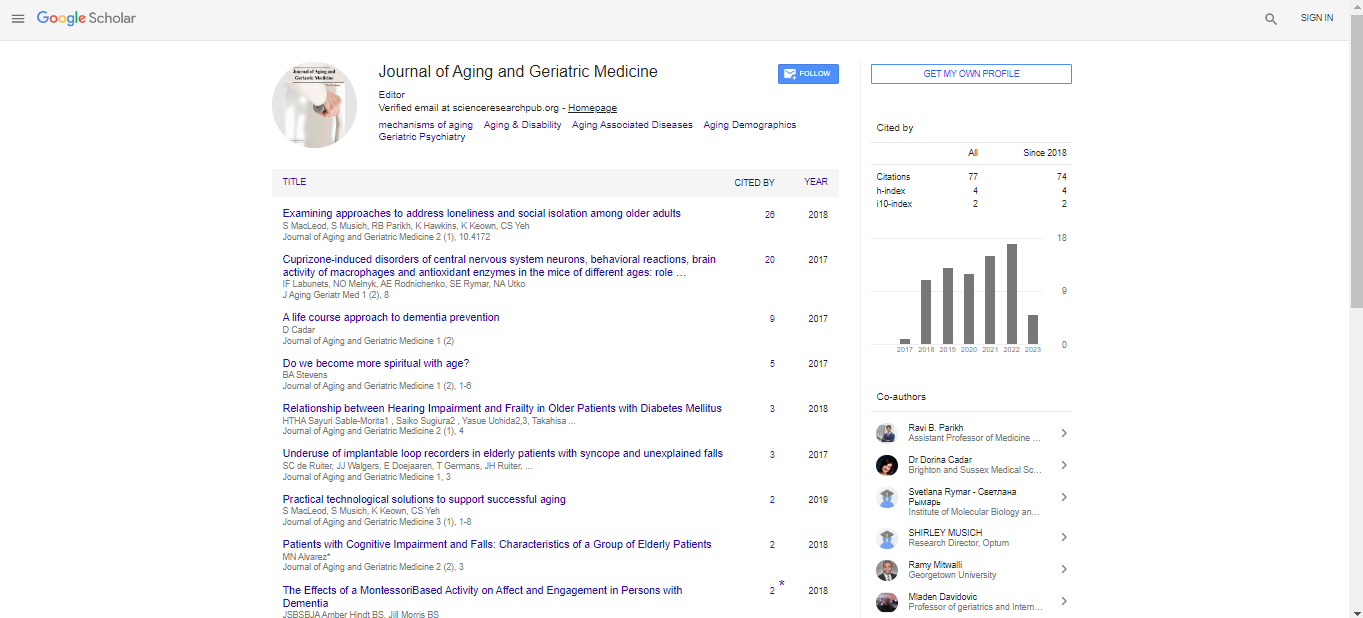Editorial, J Aging Geriatr Med Vol: 8 Issue: -1
Falls in the Elderly: Causes, Consequences and Prevention
Anthony Vinci*
Department of Health Sciences, University of Bologna, Italy
- *Corresponding Author:
- Anthony Vinci
Department of Health Sciences, University of Bologna, Italy
E-mail: vinci963@gmail.com
Received: 01-Jan-2025, Manuscript No. agm-25-169745; Editor assigned: 4-Jan-2025, Pre-QC No. agm-25-169745 (PQ); Reviewed: 18-Jan-2025, QC No. agm-25-169745; Revised: 25-Jan-2025, Manuscript No. agm-25-169745 (R); Published: 30-Jan-2025, DOI: 10.4172/2576-3946.1000179
Citation: Anthony V (2025) Falls in the Elderly: Causes, Consequences and Prevention. J Aging Geriatr Med 8:179
Introduction
Falls are one of the most common and serious health concerns affecting older adults worldwide. As individuals age, they become increasingly vulnerable to falls due to physiological changes, chronic illnesses, and environmental hazards. While a fall might seem like a minor incident for a younger person, in the elderly, it can result in severe injuries, long-term disability, psychological distress, and even death. Understanding the risk factors, consequences, and prevention strategies related to falls in the elderly is essential for improving health outcomes and maintaining independence in older populations.
Falls are a major health concern among the elderly and are one of the leading causes of injury, disability, and mortality in older adults worldwide. As individuals age, physical, sensory, and cognitive changes, combined with chronic health conditions and medication use, significantly increase the risk of falling. According to the World Health Organization, approximately one in three adults over the age of 65 experiences a fall each year, with higher rates in those over 80 [1].
Although many falls may seem minor, they can result in serious consequences such as fractures—especially hip fractures—head injuries, and long-term loss of independence. Even when injuries do not occur, the psychological impact of falling, such as the fear of falling again, can lead to reduced physical activity, social isolation, and a decline in overall health and quality of life.
Falls in the elderly are often caused by a combination of intrinsic factors—such as muscle weakness, balance disorders, vision impairment, and cognitive decline—and extrinsic factors like poor lighting, slippery floors, loose rugs, and inappropriate footwear. Polypharmacy, particularly the use of sedatives and blood pressure medications, can also increase fall risk by affecting alertness or causing dizziness [2], [3].
Preventing falls requires a multifaceted approach that includes regular health assessments, home safety modifications, physical activity to improve strength and balance, medication reviews, and vision checks. Education for both older adults and caregivers is essential in promoting awareness and encouraging preventive strategies [4], [5].
In summary, falls among the elderly are not an inevitable part of aging but a largely preventable issue. Addressing the risk factors through proactive measures can greatly enhance safety, preserve independence, and improve the overall well-being of older adults.
Discussion
Falls are a major health concern for the elderly population, often resulting in serious injuries, loss of independence, and increased mortality. Approximately one-third of people aged 65 and older experience at least one fall annually, with rates rising as age increases. The consequences of falls can range from minor bruises to severe fractures, particularly hip fractures, which are associated with significant morbidity and a decline in quality of life.
Several factors contribute to the increased risk of falls in older adults. Age-related physiological changes such as decreased muscle strength, impaired balance, slower reflexes, and vision problems play a key role. Additionally, chronic medical conditions like arthritis, stroke, Parkinson’s disease, and cognitive impairments further increase vulnerability. Medication use, especially sedatives, antihypertensives, and polypharmacy, can cause dizziness or hypotension, elevating fall risk [6], [7].
Environmental hazards, such as poor lighting, slippery floors, loose rugs, and clutter, also contribute significantly to falls. Social factors like isolation and lack of physical activity can exacerbate frailty and decrease mobility, making falls more likely.
Preventing falls in the elderly requires a multifactorial approach. Regular exercise programs focusing on strength, balance, and flexibility can reduce risk. Medication reviews to minimize sedatives and polypharmacy are crucial. Home safety assessments and modifications, such as installing grab bars and improving lighting, also help prevent falls. Moreover, addressing vision problems and ensuring proper footwear are important preventive strategies.
In summary, falls in older adults are a complex problem with multifaceted causes. Early identification of risk factors, comprehensive interventions, and community support are essential to reduce falls, improve safety, and maintain independence among the elderly population.
Conclusion
Falls in the elderly are a serious public health issue with significant physical, emotional, and economic consequences. As the global population continues to age, the burden of fall-related injuries will increase unless preventive actions are prioritized. By addressing modifiable risk factors, promoting physical activity, and ensuring safer environments, we can help older adults maintain independence and quality of life. Ultimately, fall prevention is not only a medical priority but a social responsibility that requires collaboration between individuals, families, healthcare providers, and communities.
References
- Jakobsen LP, Knudsen MA, Lespinasse J, Ayuso CG, Ramos C, et al. (2006) The genetic basis of the Pierre Robin Sequence. Cleft Palate Craniofac J 43: 155-159.
- Dobby N, Black A, Ong KB (2012) Airtraq vs Glidescope airway management of a pediatric population with a documented difficult airway; Cormack and Lehane Grade III or IV. Pediatr Anesth 22: 921.
- Asai T, Nagata A, Shingu K (2008) Awake tracheal intubation through the laryngeal mask in neonates with upper airway obstruction. Paediatr Anaesth 18: 77-80.
- Asai T, Shingu K (2004) Difficulty in advancing a tracheal tube over a fibreoptic bronchoscope: incidence, causes and solutions. Br J Anaesth 92: 870-881.
- Parotto M, Cooper RM, Behringer EC (2020) Extubation of the Challenging or Difficult Airway. Curr Anesthesiol Rep 4: 1-7.
Indexed at, Google Scholar, Crossref
Indexed at, Google Scholar, Crossref
Indexed at, Google Scholar, Crossref
 Spanish
Spanish  Chinese
Chinese  Russian
Russian  German
German  French
French  Japanese
Japanese  Portuguese
Portuguese  Hindi
Hindi 